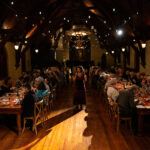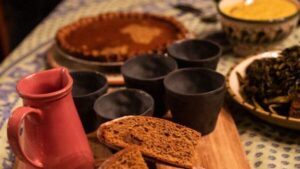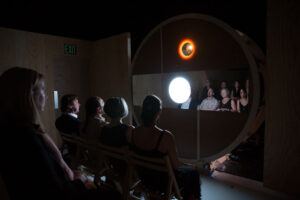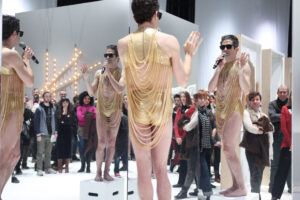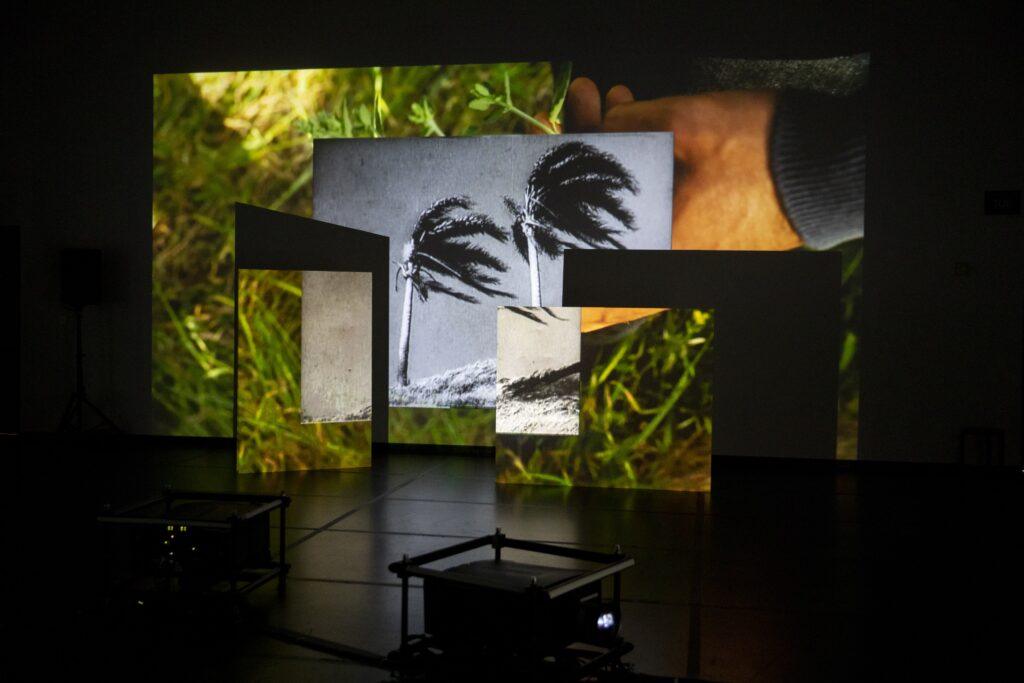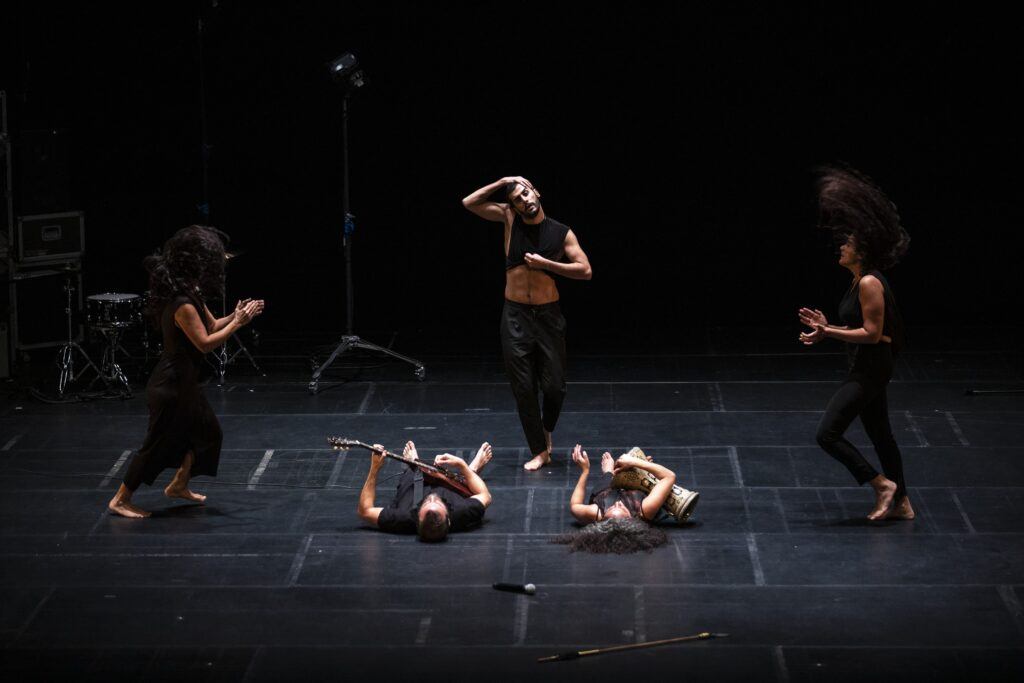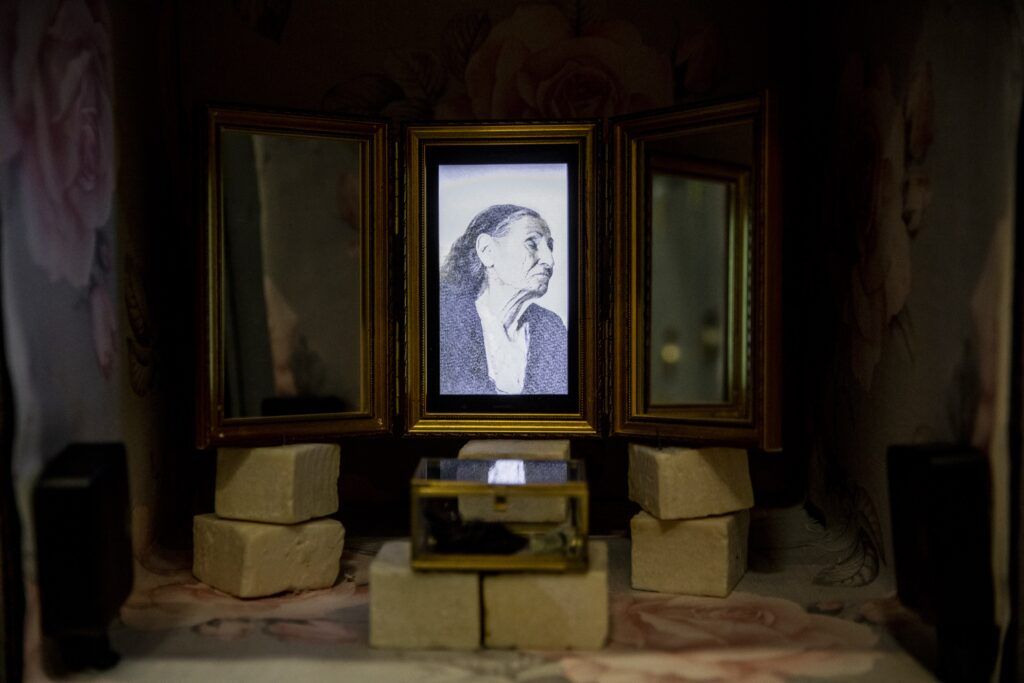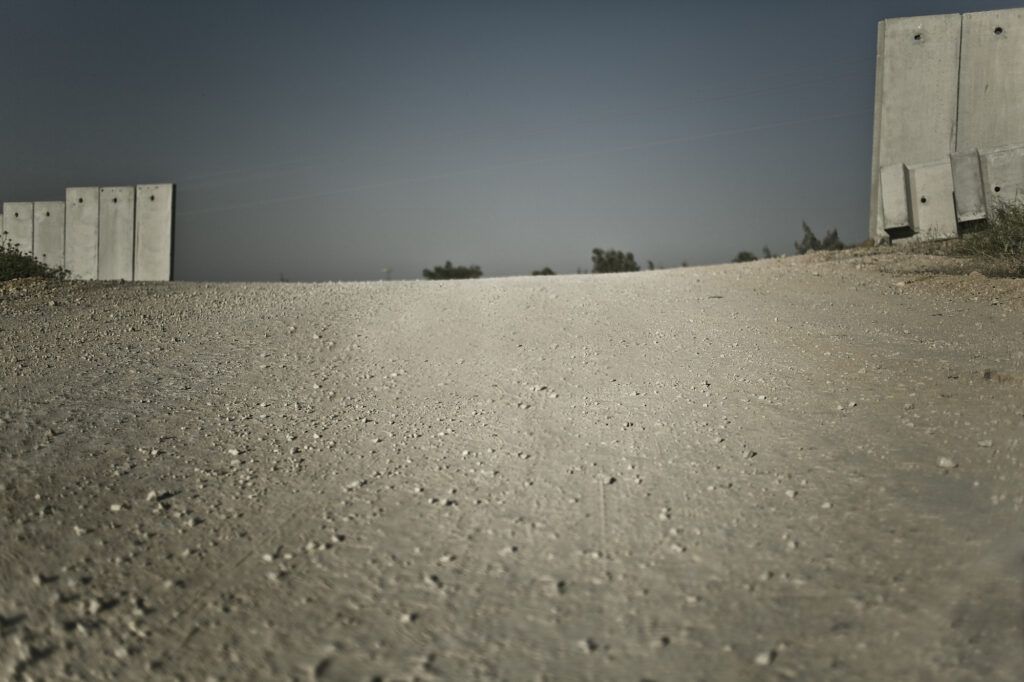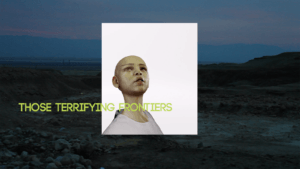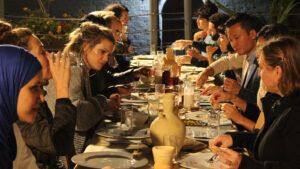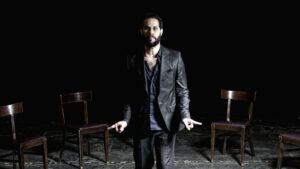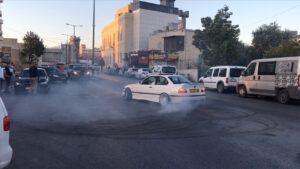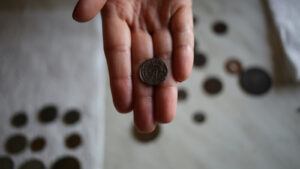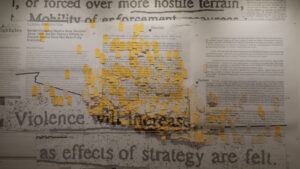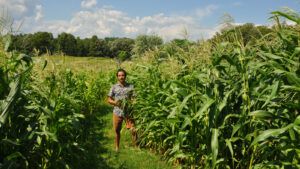A four-day festival on the subject of borders—physical borders, political borders, and borders of the body—and how we might in time transcend them.
This third edition of the LAB Biennial was co-curated by Lebanese artist Tania El Khoury, a 2019 Soros Art Fellow, and Gideon Lester, the Fisher Center’s Artistic Director for Theater and Dance. The festival featured nine new performances and installations by contemporary artists from the Middle East and the Americas.
Credits
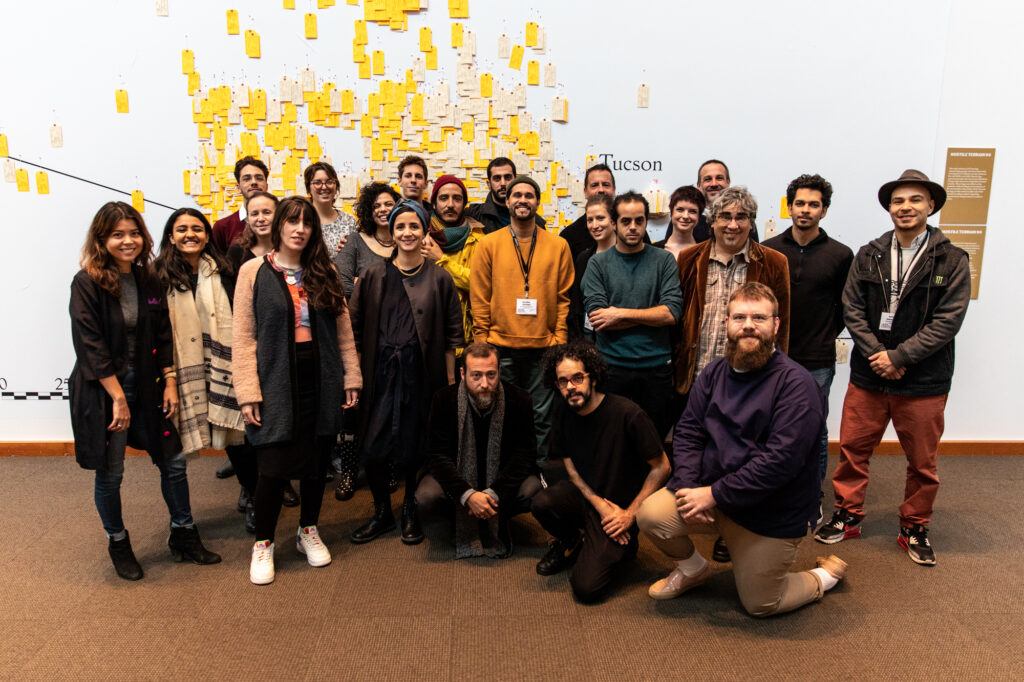 Co-Curators Tania El Khoury and Gideon Lester
Co-Curators Tania El Khoury and Gideon Lester
Festival Artists
Basel Abbas and Ruanne Abou-Rahme with Tashweesh
Mirna Bamieh/Palestine Hosting Society
Ali Chahrour
Rudi Goblen
Emily Jacir
Tania El Khoury
Jason De León
Emilio Rojas
Curatorial Fellows Sukanya Baskar CCS ’20, Thea Spittle CCS ’19, and Triston Tolentino ’18
Festival Producers Caleb Hammons and Cathy Teixeira
Festival Photographer Maria Baranova
Read the Full ProgramCurators' Note
They say there is a window from one heart to another.
How can there be a window where no wall remains?
—Rumi, from Thief of Sleep
Where No Wall Remains is the third edition of the Live Arts Bard (LAB) Biennial, a festival of commissioned works that temporarily reconfigures the Fisher Center as a site for innovative and interactive performances and installations. The first edition, The House Is Open (2014), explored the relationship between visual and performing arts; the second, We’re Watching (2017), examined contemporary states of surveillance. We started planning the third edition in January 2017, in the week that the Trump administration’s “Muslim ban” came into effect, accompanied by increasingly xenophobic rhetoric and the specter of a wall along the U.S.-Mexico border. It was inevitable that the current edition would focus on the subject of borders.
November 2019, the month of the festival, marks the 30th anniversary of the fall of the Berlin Wall. One of the most significant and celebrated events of the 20th century, at the time it seemed to promise a future of open borders and unification. Three decades later, the heady dreams of 1989 are very far from us; walls are being built, not torn down. The recent near-elimination of America’s immigration program, together with an increase of human rights violations on the Mexican border, have made the festival’s subject even more grimly present than we could have imagined in 2017. Current U.S. immigration policy has particularly affected people from the Middle East and Central America, and we therefore invited artists from those regions to join us in creating the festival.
The title Where No Wall Remains, taken from a love poem by Rumi, invites us to imagine a utopian state of being—a fully unbordered world. The festival comprises nine new artistic works that engage with the notion of borders: political, physical, historical, and contemporary; borders seen and unseen; the borders of the body; borders between art forms, performers, and spectators; borders that divide or define us; borders to be crossed, tested, resisted, destroyed, rebuilt, or transcended.
Festival venues include the Fisher Center, Bard College Farm, and the nearby village of Tivoli, New York. The political potential of each work evokes many ideas and representations of borders: letter to a friend, FITO, and Cultural Exchange Rate recenter the political debate around the personal, presenting autobiographical, familial, and neighborhood accounts of border crossing and navigating broader systems of oppression; Night brings the audience to the most intimate site of alien- ation, the human body, reminding us that love stories are also about borders and how we transcend them. The entire program reflects the urgency of our political climate, not by merely advancing critique but by also producing knowledge. Works such as Hostile Terrain 94 (HT94); Menu of Dis/appearance; m(Other)s: Hudson Valley; and At those terrifying frontiers where the existence and disappearance of people fade into each other (part 2) engage dispossessed bodies, erased cultures, and forgotten artifacts. Naturalized Borders (to Gloria) redraws the U.S.-Mexico border as an imagined line by communities who have historically asserted the inter- section between labor rights, land sovereignty, and migration. We are reminded of the everyday price many people pay for borders: the marginalization of indigenous communities, the uncounted and unrecorded deaths at border zones, and the era- sure of entire lifeworlds. The festival’s cover image, Samar Hazboun’s photograph of the wall in her town of Bethlehem, represents a global community of artists who refuse to be imprisoned by racism or cement.
The festival is the culmination of a two-year partnership with many Bard programs (including Middle Eastern Studies, Latin American and Iberian Studies, Experimental Humanities, and the Human Rights Project), and has included undergraduate courses, public events, and artist residencies. We are talking with colleagues across the Bard network about future iterations of Where No Wall Remains at Bard College Berlin, Al-Quds Bard, and in other cities dominated by the past, present, or future political reality of border walls.
We acknowledge the vast body of work that came before this festival by artists and activists who are most affected by discriminatory border politics. We pay homage to them and hope to build on the ongoing discussion and mobilization on borders with this timely and inspiring body of work.
—Tania El Khoury and Gideon Lester
Works
BASEL ABBAS AND RUANNE ABOU-RAHME WITH TASHWEESH
AT THOSE TERRIFYING FRONTIERS WHERE THE EXISTENCE AND DISAPPEARANCE OF PEOPLE FADE INTO EACH OTHER (PART 2)
At those terrifying frontiers where the existence and disappearance of people fade into each other (part 2) brings together a site-specific video and sound installation by Palestinian American artists Basel Abbas and Ruanne Abou-Rahme and a new performance by Tashweesh with musician/performer Muqata’a. The combination of their different practices, in a joint performance using sound, music, and images, results in an exploration of the collision between returns, erasure, and disruption.
From the returns of the land and stubborn vegetation that does not die, to artifacts that are reactivated as living matter, figures that return in virtual form, and disruptive bodies that keep reappearing on borders, both the installation and performance address the intentional erosion of bodies, land, and structures in different forms, and also their reappearance in spaces where they “should not be.” These projects invite us to consider the forms of entanglement between the destruction of bodies and the erasure of images, and the conditions under which these same bodies and images might reappear.
MIRNA BAMIEH/PALESTINE HOSTING SOCIETY
MENU OF DIS/APPEARANCE
In its first dinner performance in the United States, the Palestine Hosting Society presents an approach to “Palestinianess” that trespasses borders and geographies through a menu that brings together dishes from Palestinian cities and villages, refugee camps outside Palestine, and those that narrate intergenerational food habits and memory of the Palestinian diaspora, especially in the United States. Menu of Dis/appearance narrates stories about time, history, and parts of ourselves that we might have allowed to slip away.
Menu of Dis/appearance invites the audience on a journey through a selection of dishes that reflects the Palestine Hosting Society’s investigation and unearthing of traditional Palestinian cuisine. Some have been forgotten, their names rendered abstract to the current generation of Palestinians. Being denied a state of their own, Palestinians use food to express an identity that is constantly undermined. Life under occupation atrophied this connection to food, through imposing restrictive policies over food and water resources and inflicting control on wild plant foraging, as well as creating dissonance by showcasing Palestinian dishes as Israeli. Over the years, such measures created a kitchen that is dispossessed, making many traditional Palestinian dishes disappear, or be temporarily withdrawn.
ALI CHAHROUR
NIGHT
Night, from Lebanese choreographer Ali Chahrour, is a dance concert inspired by the dense archive of love and romance in classical Arabic poetry, and from contemporary stories of lovers and their cruel separations. The work references stories from the cultural memory of the Levant and Mesopotamia about the fate of lovers who challenged social and religious systems, and whose bodies were punished and sentenced to suffer the distance of separation as well as the hope of impossible reunions.
The performance records the vicissitudes of lovers and their resistance, leading up to the moment when they fall and fade away. The exhausted body succumbs, and with it falls every action and instrument/tool that the performers had carried throughout the show. The fall reveals the fragility of the lover/performer, and the frailty of methods and tools at his disposal. The stage becomes the battlefield after the battle, where the audience has just witnessed the death or, rather, the birth of its heroes.
RUDI GOBLEN
FITO
After 30 years in the United States, it is the day of Fito’s naturalization ceremony. As he raises his hand for the Oath of Allegiance, he is transported to a composition of musical snapshots that make up his tapestry in this country. Some are jaded, some moot, some filled with bodies of water, some disheartening—but none ever debilitating enough to keep him from chasing his dream to be the first American citizen in his family. FITO is an interactive concert-play incorporating songs, stories, and spoken-word poems that meld to paint a soundscape of what it can take to be accepted in your own home, by your own people—or yourself.
EMILY JACIR
Letter to a friend
The artist asks a friend to start an investigation and recounts in minute detail various aspects of her home and street in Bethlehem—a site marked by movement, migration, survival, and war.
TANIA EL KHOURY
CULTURAL EXCHANGE RATE
The cruelest borders are invisible to the eye and present in everyday life: the death traps set within a moving body of water and the concealed militarization of faraway border villages. Cultural Exchange Rate is an interactive live art project in which artist Tania El Khoury shares her family memoirs of life in a border village between Lebanon and Syria, marked by war, survival, valueless currency collections, brief migration to Mexico, and a river that disregards colonial and national borders.
Audience members are invited to immerse themselves in one family’s secret boxes to explore the sounds, images, and textures of traces of more than a century of border crossings.
Cultural Exchange Rate is based on the artist’s recorded interviews with her late grandmother, oral histories collected in her village in Akkar, the discovery of lost relatives in Mexico City, and the family’s attempt to secure dual citizenship.
JASON DE LEÓN
HOSTILE TERRAIN 94 (HT94)
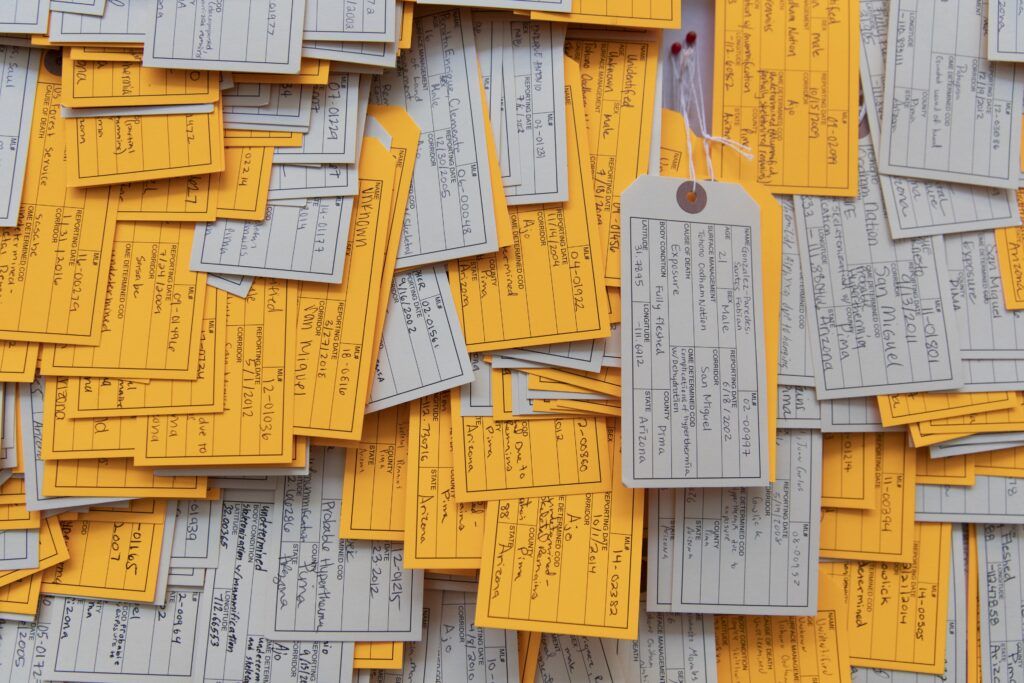 Hostile Terrain 94 (HT94) is a prototype of a participatory political art installation organized by the Undocumented Migration Project that launches simultaneously in 150 locations around the globe in fall 2020. A 20-foot-long map of the Arizona/ Mexico border is populated with 3,117 handwritten toe tags that contain information about those who have died while migrating, including name (if known), age, sex, cause of death, condition of body, and location. Some tags contain QR and augmented-reality codes that link to content related to migrant stories, and visuals connected to immigration that can be accessed via cell phone. HT94 is intended to memorialize and bear witness to the thousands who have died as a result of the U.S. Border Patrol’s immigration enforcement strategy known as “Prevention Through Deterrence.”
Hostile Terrain 94 (HT94) is a prototype of a participatory political art installation organized by the Undocumented Migration Project that launches simultaneously in 150 locations around the globe in fall 2020. A 20-foot-long map of the Arizona/ Mexico border is populated with 3,117 handwritten toe tags that contain information about those who have died while migrating, including name (if known), age, sex, cause of death, condition of body, and location. Some tags contain QR and augmented-reality codes that link to content related to migrant stories, and visuals connected to immigration that can be accessed via cell phone. HT94 is intended to memorialize and bear witness to the thousands who have died as a result of the U.S. Border Patrol’s immigration enforcement strategy known as “Prevention Through Deterrence.”
The most crucial (and interactive) aspect of the installation is the act of audience members committing their time and energy to meticulously fill out the death details for all 3,117 toe tags, and then placing these tags in the exact locations on the map where those individuals were found.
EMILIO ROJAS
NATURALIZED BORDERS (TO GLORIA)
 Naturalized Borders (to Gloria) is the first iteration of a multifaceted, interactive land art and community-based project, including a 72-foot-long line of indigenous crops (corn, beans, and squash, known as “the three sisters”) planted in the shape of the U.S.-Mexico border line on the Bard College Farm. It includes the harvesting, sharing, and clearing of crops and land; a mobile paleta cart-turned-drawing studio upon which persons of any background are invited to memorialize real or imagined borders; and the documentation and archive from various stages of the project. Continuing the legacy of Chicana feminist writer Gloria E. Anzaldúa, the work seeks to unearth histories of immigration, labor rights, borders, land sovereignty, and systemic oppression.
Naturalized Borders (to Gloria) is the first iteration of a multifaceted, interactive land art and community-based project, including a 72-foot-long line of indigenous crops (corn, beans, and squash, known as “the three sisters”) planted in the shape of the U.S.-Mexico border line on the Bard College Farm. It includes the harvesting, sharing, and clearing of crops and land; a mobile paleta cart-turned-drawing studio upon which persons of any background are invited to memorialize real or imagined borders; and the documentation and archive from various stages of the project. Continuing the legacy of Chicana feminist writer Gloria E. Anzaldúa, the work seeks to unearth histories of immigration, labor rights, borders, land sovereignty, and systemic oppression.
EMILIO ROJAS
M(OTHER)S: HUDSON VALLEY

m(Other)s: Hudson Valley is a series of video portraits of immigrant women, both documented and undocumented, holding their first-generation children. Inspired by the “hidden mother” photographs common from the advent of photography up until the 1920s—a standard practice requiring the mother to hold the child still while being covered and remaining invisible in the interest of foregrounding the child— these portraits seek to connect the political and social situation of women at the turn of the 20th century with the invisibility of the labor of immigrant women today.
Theater Journal
Where No Wall Remains: Projects on Borders and Performance
An issue of Theater • Volume 51, Number 1 • Published February 2021
 Built around the Live Arts Bard 2019 Biennial of the same name, “Where No Wall Remains” is a record of performances and interactive art projects by international artists on the subject of borders. The artists mark the thirtieth anniversary of the fall of the Berlin Wall through an exploration of contemporary borders in kaleidoscopic forms: political, physical, psychological, culinary, autobiographical. As the United States accepts fewer and fewer immigrants, ICE commits human rights violations at the Mexican border, and international borders close due to COVID-19, these newly commissioned performances hold urgent significance. Although the state of the world and its borders is dire, “Where No Wall Remains,” a phrase taken from a love poem by Rumi, invites us to imagine not only our xenophobic present, but a future utopian state of being—a fully unbordered world.
Built around the Live Arts Bard 2019 Biennial of the same name, “Where No Wall Remains” is a record of performances and interactive art projects by international artists on the subject of borders. The artists mark the thirtieth anniversary of the fall of the Berlin Wall through an exploration of contemporary borders in kaleidoscopic forms: political, physical, psychological, culinary, autobiographical. As the United States accepts fewer and fewer immigrants, ICE commits human rights violations at the Mexican border, and international borders close due to COVID-19, these newly commissioned performances hold urgent significance. Although the state of the world and its borders is dire, “Where No Wall Remains,” a phrase taken from a love poem by Rumi, invites us to imagine not only our xenophobic present, but a future utopian state of being—a fully unbordered world.
Special Issue Editors Tania El Khoury and Tom Sellar
Contributors Basel Abbas, Ruanne Abou-Rahme, Mirna Bamieh, Ali Chahrour, Jason de León/Undocumented Migration Project, Tania El Khoury, Rudi Goblen, Gideon Lester, Alex Ripp, Emilio Rojas, Tom Sellar, Ashley Thomas
Read the Issue
Festival Blog
Learn more about the artists and projects in Where No Wall Remains, via blog posts and artist biographies written by curatorial fellows Sukanya Baskar CCS ’20, Thea Spittle CCS ’19, and Triston Tolentino ’18.
Explore the Blog
Syllabus
 Revisiting a model introduced during the 2014 edition of the Biennial, the festival syllabus has situated the festival within a larger geographical and political context. The 2019 Biennial’s syllabus addresses borders and migration through rigorous and scholastic engagement with different perspectives on the theme. Understanding that the festival takes place at a time when our understanding of borders and migration transcends specific geographies or individuals, the syllabus provides multiple entry points into this layered subject.
Revisiting a model introduced during the 2014 edition of the Biennial, the festival syllabus has situated the festival within a larger geographical and political context. The 2019 Biennial’s syllabus addresses borders and migration through rigorous and scholastic engagement with different perspectives on the theme. Understanding that the festival takes place at a time when our understanding of borders and migration transcends specific geographies or individuals, the syllabus provides multiple entry points into this layered subject.
Grounded in conversations with the Fisher Center LAB Festival artists and curators, the syllabus weaves together texts, media, and other sources integral to their artistic and intellectual practices. These resources were accessible through the Reading Room at New Annandale House on the Bard College campus.
This unique festival, serving Bard undergraduate and graduate students, as well as the larger community, requires us to integrate the festival into an educational framework that reflects the complexities of the present global condition. This syllabus is structured to initiate dynamic conversations within the Bard community and beyond, culminating (but not terminating) in the festival in November 2019.
Explore the Syllabus